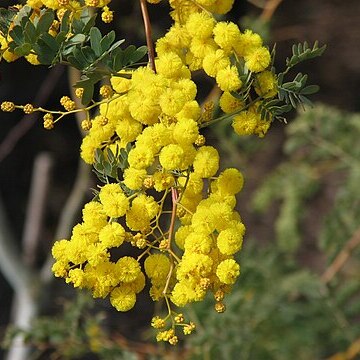Unarmed shrub to c. 5 m high. Branchlets glaucous, with ± dense indumentum of spreading hairs up to 0.2 mm, glabrescent. Leaves bipinnate, with indumentum as the branchlets; petiole 0.6-1.8 cm, one gland just below the junction of the proximal pur of pinnae; rachis 2-7(-9.5) cm, glandless; pinnae 3-5(-7) pairs, 1-3 cm, leaflets opposite, sessile, 4-6(-8) pairs, oblong-obovate, obtuse, 6-11 (-13) by 2.5-5 mm, getting progressively larger along pinnae and terminal ones sometimes brbadest near the apex, glabrous. Inflorescences composed of flower-heads of 15-20 flowers, aggregated into long axillary racemes or rarely in terminal panicles. Pod linear, flat, convex over the seieds, glaucous, glabrous, to 11 by 1.2-1.5 cm. Seeds longitudinal, c. 6 by 3.5 mm, pleurogram constricted at the hilar end, but open; funicle expanded into a cupular aril.
An evergreen shrub. It grows 5 m tall and spreads 2 m wide. The stem is erect and tall and fragile. The branches are nearly round in cross section. They are often bent and twisted. The leaves (phyllodes) are greyish-green and like a feather. They have 2 to 4 divisions of the leaves. Each division has 4 to 8 oval leaflets. The flowers are bright yellow balls. They occur as many flowers in a cluster. This makes it a very ornamental wattle. The pods are 5-10 cm long by 1-1.5 cm across. They are brown.


